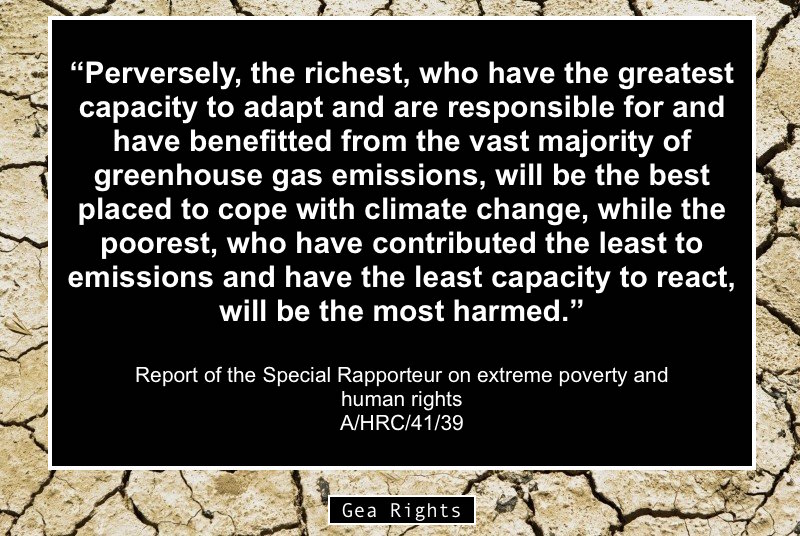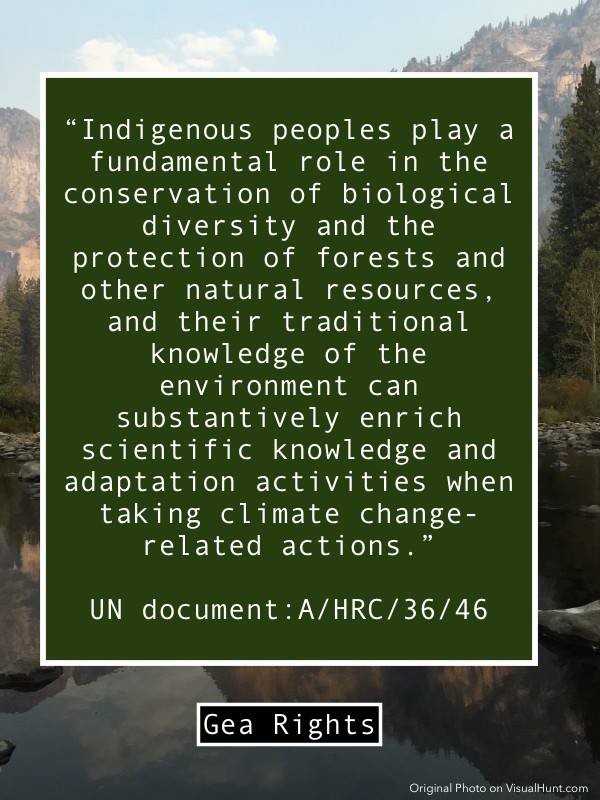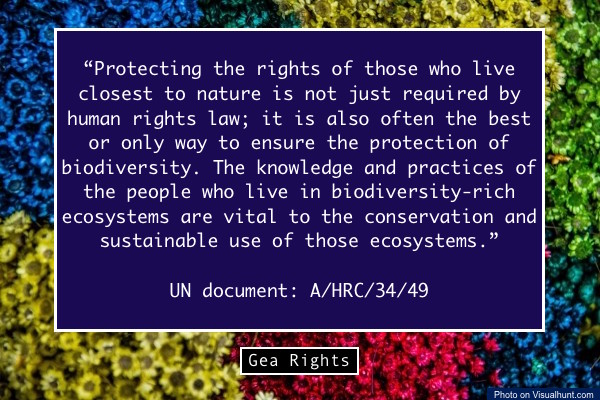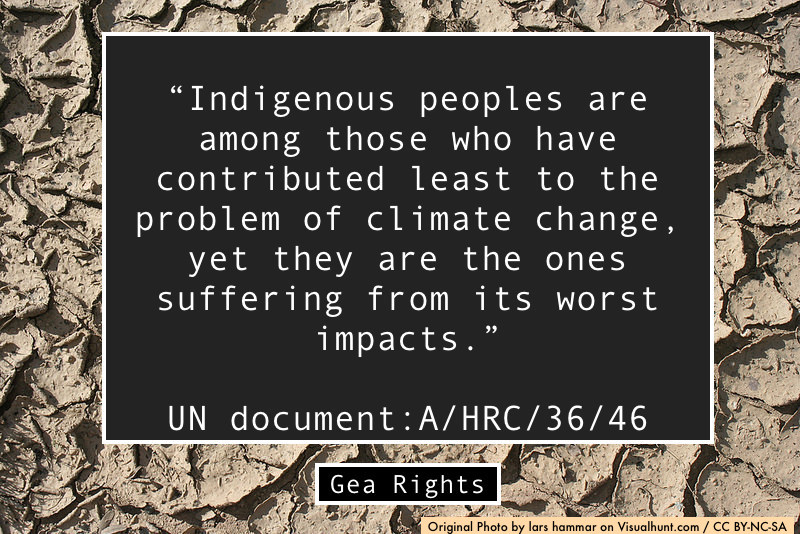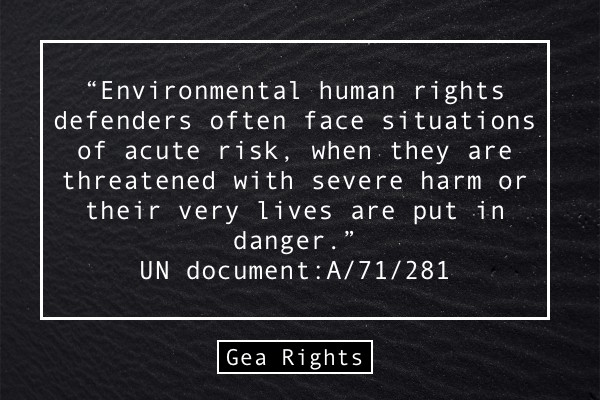When talking about the protection of Nature, is crucial to stress the role of Indigenous peoples, whose cosmovision and strenuous fight for the protection of the planet have shaped and given a decisive impulse to recognition of the rights of Nature. The Earth-centered legal innovations that have taken place in many parts of the world, in fact, are strongly influenced by the cosmovision of the Indigenous peoples living in those territories. Thomas Berry often cites the role of guidance of Indigenous peoples in the development of a new era:
“As the years pass it becomes even more clear that dialogue with native peoples here and throughout the world is urgently needed to provide the human community with models of a more integral human presence to the Earth.”[1]
The link between biological diversity and cultural diversity is a vital aspect of environmental protection.[2] The Declaration of Belém, adopted in 1988 during the First International Congress of Ethnobiology, recognized for the first time that “native peoples have been stewards of 99 percent of the world’s genetic resources” and the “inextricable link between cultural and biological diversity”.[3] The Declaration also urged to recognize Indigenous specialists as “proper authorities”, to be consulted “in all programs affecting them, their resources and their environment”.[4]
The same approach was adopted by the Convention on Biological Diversity of 1992 (CBD) that, in the context of in-situ conservation, recognizes the importance of the knowledge, innovations and practices of Indigenous peoples and local communities in the conservation and sustainable use of biological diversity.[5] The Joint Programme between the Secretariat of the CBD and UNESCO on Linking Biological and Cultural Diversity, along with the numerous declarations on bio-cultural diversity, furtherly develop and acknowledge the role of Indigenous peoples and their traditional knowledge in the conservation of biodiversity.[6] Several studies have shown that Indigenous and local communities’ management of the biological resources limits the negative impacts of their activities.[7] In particular, anthropologists, linguists and biologists have found a parallelism between the diversity of species and the linguistic and cultural diversity.[8] Mesoamerica, for example, a “megacenter” of biological diversity, is particularly rich in cultural and linguistic diversity, counting more than 200 language groups.[9]
As it will emerge in the next paragraphs, the cosmovision of Indigenous peoples can be considered as the cultural substrate of the rights of Nature’s recognition in domestic legal systems. The Indigenous worldview is slowly emerging and becoming visible in the legislative process, judgments and politics of the lands colonized by Europeans and their descendants, after centuries of cultural annihilation and extreme violence that led to consider Indigenous peoples as incapable of producing culture and knowledge. In this perspective, the emergence of the rights of Nature needs to be seen not only as an environmental revolution and legal innovation, but also as the resurfacing of a worldview that, for centuries, has been oppressed and condemned to silence.
As stated by Quidel Lincoleo, Mapuche scholar, the relationship between the Natives and the colonizers was characterized, since the very beginning, by the attempt to erase the Indigenous culture and way of life (my translation, original texts in Mapuzugun and Spanish below):
“As soon as those from across the sea arrived, they looked down on us who lived here. They did not even consider us people, they even wrote their dreadful perceptions about the groups in these lands. They even doubted on whether we had a soul, they considered that our lives were very close to the life of the animals, they even took many people only to show them in their lands, as if we were animals. […] Those who came from beyond the sea were morbidly surprised by everything. […] Thus, because of our ways of living, we transformed into beings full of guilt. The gaze of another way of living transformed us into despicable beings.” [10]
The annihilation of the Indigenous knowledge and cosmovision was achieved through the prohibition of their language, rich of spiritual meanings, violence and humiliation.
“The first thing they had to silence was our language. For this reason, they sentenced the Mapuzugun to end, that sound to be extinguished, the Mapuche singing not to continue, the Mapuche crying to end, the Mapuche falling in love, the singing to work, the ritual singing, the words of the rituals, in where all lives could be transformed into speech. In this way, our thoughts were silenced, our knowledge too, the other talking, their talking broke into our lives, into our daily lives. […] For the bodies, the ancient art of torturing and punishing brought by those who arrived first consisted of beheading, cutting hands, impalement on the pike, hitting, sinew cutting, curtailment of breasts, clubbing and spanking. […] Our knowledge was never valued, it was despised, it was not considered. That’s how they came to think of us as people lacking knowledge. And our precious spiritual knowledge was demonized so that it would not reproduce, it was labeled as knowledge that came directly from the devil.”[11]
The recognition of the rights of Nature in national legal systems: three examples
A new Earth-centered approach has found space in the legal systems of several States.[12] We will analyze only a few examples in order to understand how this approach has been expressed in the domestic laws.
The Republic of Ecuador – Ikwadur Ripuwlika – Ekuatur Nunka
The Constitution of Ecuador was the first one to recognize the rights of Nature in 2008.[13]
The Preamble contains the celebration of the Pacha Mama, Mother Earth,
“of which we are part and which is vital to our existence” and the commitment to build a “new form of public coexistence, in diversity and in harmony with nature, to achieve the good way of living, the sumak kawsay”.[14]
Sumak Kawsay is a Quechua expression that arises from the cosmovision of Indigenous Peoples.[15] It is translated in the Ecuadorian Constitution with Buen Vivir, but this expression should be considered as a simplification, as it does not fully shows the complexity that lies behind the sumak kawasay.[16] Used in several Latin American countries, each Indigenous group gives to the expression Buen Vivir (or Vivir Bien) a specific, unique connotation, but its shared, common value is that of an harmonious relationship with Mother Earth, Nature and all living beings.[17] According to several authors, Buen Vivir not only should be considered an alternative to the Western concept of development, but also a perspective that goes beyond the Western paradigms.[18] In the Ecuadorian Constitution there are numerous references to Sumak Kawsayand Buen Vivir, in particular in Title II – Chapter II “Derechos del Buen Vivir” (Rights of Buen Vivir) and in Title VII “Regimen del Buen Vivir” (Regime of Buen Vivir), where it appears as the main and ultimate goal of the political action.
Under Chapter 7, titled Derechos de la naturaleza, (Rights of nature), Articles 71 and 72 of the Constitution recite:
“Article 71. Nature, or Pacha Mama, where life is reproduced and occurs, has the right to integral respect for its existence and for the maintenance and regeneration of its life cycles, structure, functions and evolutionary processes.
All persons, communities, peoples and nations can call upon public authorities to enforce the rights of nature. To enforce and interpret these rights, the principles set forth in the Constitution shall be observed, as appropriate.
The State shall give incentives to natural persons and legal entities and to communities to protect nature and to promote respect for all the elements comprising an ecosystem.
Article 72. Nature has the right to be restored. This restoration shall be apart from the obligation of the State and natural persons or legal entities to compensate individuals and communities that depend on affected natural systems.
In those cases of severe or permanent environmental impact, including those caused by the exploitation of nonrenewable natural resources, the State shall establish the most effective mechanisms to achieve the restoration and shall adopt adequate measures to eliminate or mitigate harmful environmental consequences.”[19]
De Sousa Santos asserts that the rights of Nature in Ecuador are a “de-colonial legal and cultural hybrid”, that merges the Western concept of rights with the Quechua concept of Nature, the Pacha Mama, a living organism that sustains life.[20]He uses the expression “epistemologies of the South” to indicate a needed transformation “to reinvent social emancipation on a global scale”, on the basis of concepts that overcome the Western perspective on the world.[21] To de Sousa Santos, the South is a “metaphor for the human suffering caused by capitalism and colonialism on the global level”.[22] These epistemologies are not usually considered as “knowledge”, but rather superstition, opinions or common sense, only because they do not correspond to a “rigorous”, Western-centric idea of knowledge.[23] The magnitude of the change brought by the Constitution of Ecuador, then, must be found in the capability to consider as knowledge a set of values, principles and worldviews, labeled as primitive for centuries, and to insert them in a legal instrument as the guiding principles of the Country, setting an example for the rest of the world.
The Plurinational State of Bolivia
The Preamble of the Bolivian Constitution, adopted in 2009, starts with a statement on the sacredness of Mother Earth, the plurality and diversity within Nature and peoples:
“In ancient times mountains arose, rivers moved, and lakes were formed. Our Amazonia, our swamps, our highlands, and our plains and valleys were covered with greenery and flowers. We populated this sacred Mother Earth with different faces, and since that time we have understood the plurality that exists in all things and in our diversity as human beings and cultures. Thus, our peoples were formed, and we never knew racism until we were subjected to it during the terrible times of colonialism.”[24]
Law 071/2010 “Ley de Derechos de la Madre Tierra” (Law of the Rights of Mother Earth) was approved by the Bolivian Legislative Assembly in 2010. In Article 3, Mother Earth is described as a dynamic living system, formed by an indivisible community of systems of life and living beings, sharing a common destiny as they are “interdependent, interrelated and complementary”.[25] According to the cosmovision of Indigenous peoples and nations, Mother Earth is considered sacred.[26] In Article 5, Mother Earth is described as a “collective subject of public interest”, a subject of rights to be exercised by the Bolivian people.[27] The individual rights are limited by the collective rights, and any conflict among them must be solved in a way that does not affect irreversibly the functionality of the life systems.[28] The rights of Mother Earth established by the law are in particular: the right to life; to the diversity of life; to water; to clean air; to equilibrium; to restoration; to live free of contamination.[29] Article 8 demands the State to develop, among others, a balanced system of production and consumption in accordance with the Vivir Bien, to defend the Earth on a plurinational and international level from overexploitation and commodification of its life systems and processes, and from climate change’s causes and effects.[30]
Law 300/2012 “Ley Marco de la Madre Tierra y Desarrollo Integral para Vivir Bien” (Framework Law of Mother Earth and Integral Development for Vivir Bien) establishes the principles to be followed in the context of Law 071/2010, for a development in harmony and equilibrium with Mother Earth in accordance with the Vivir Bien.[31] The Vivir Bien (Sumaj Kamaña, Sumaj Kauasay, Yaiko Kavi Päve) is described as an alternative to Capitalism and modernity that rise from the Indigenous cosmovision along with the intercultural and Afrobolivian communities.[32] It means “to live in complementarity, in harmony and equilibrium with Mother Earth and the societies, in equity and solidarity and eliminating inequalities and mechanisms of domination.”[33] The values of Vivir Bien are described in Article 6 as a form of “saberes”, of knowledge: to know how to grow; how to eat; how to dance; how to work; how to communicate; how to dream; how to listen; how to think (which also includes the capability to feel).[34] These forms of knowledge are strictly connected to a life in harmony with Mother Earth and find in the Indigenous worldview and sensitivity their nourishment.
Bolivia has given a decisive impulse to the commencement and development of a discourse within the United Nations, aimed at finding new solutions to the environmental crisis within the programme “Harmony with Nature”.
Aotearoa New Zealand
In the last few years, Aotearoa New Zealand, has recognized a number of ecosystems as legal persons.[35]
Before the arrival of Europeans, the areas around the Whanganui river, one of the longest of New Zealand, were densely populated by Maōri tribes (iwi) which exercised their authority and customs over it.[36] The situation changed with the arrival of the Europeans and the signing of the Treaty of Waitangi in 1840.[37] The tribes, however, never stopped claiming their rights over the river.[38]
In 2017 the “Te Awa Tupua (Whanganui River Claims Settlement) Act” declared the Whanganui River as a legal person, called Te Awa Tupua, which is “an indivisible and living whole, comprising the Whanganui River from the mountains to the sea, incorporating all its physical and meta- physical elements”.[39] In the Act it is evident the frequent utilization of Māori terminology and the numerous references to their cosmovision, where rivers as seen as the “embodiment of their ancestors, tupuna”.[40] Tupua Te Kawa indicates the intrinsic value, the essence of the Te Awa Tupua.
In particular, Section 13 states:
“Ko Te Kawa Tuatahi
(a) Ko te Awa te mātāpuna o te ora: the River is the source of spiritual and
physical sustenance:
Te Awa Tupua is a spiritual and physical entity that supports and sustains both the life and natural resources within the Whanganui River and the health and well-being of the iwi, hapū, and other communities of the River.
Ko Te Kawa Tuarua
(b) E rere kau mai i te Awa nui mai i te Kahui Maunga ki Tangaroa: the
great River flows from the mountains to the sea:
Te Awa Tupua is an indivisible and living whole from the mountains to the sea, incorporating the Whanganui River and all of its physical and metaphysical elements.
Ko Te Kawa Tuatoru
(c) Ko au te Awa, ko te Awa ko au: I am the River and the River is me:
The iwi and hapū of the Whanganui River have an inalienable connection with, and responsibility to, Te Awa Tupua and its health and well- being.
Ko Te Kawa Tuawhā
(d) Ngā manga iti, ngā manga nui e honohono kau ana, ka tupu hei Awa Tupua: the small and large streams that flow into one another form one River:
Te Awa Tupua is a singular entity comprised of many elements and communities, working collaboratively for the common purpose of the health and well-being of Te Awa Tupua.”[41]
As a legal, person, the Te Awa Tupua has “all the rights, powers, duties, and liabilities of a legal person” to be exercised by the Te Pou Tupua[42] considered as the “human face” of the Te Awa Tupua.[43] and formed by two people, one appointed by the Whanganui iwi having an interest in the river, and one on behalf of the Crown.[44] The Act also contains a formal apology to the Whanganui iwi from the Crown for the past actions and omissions, and a commitment to begin a healing process.[45] It also acknowledges the Maōri cosmovision and relationship with the river.[46]
According to Collins & Esterling, however, the Act embraces cultural rights, but as it does not offer the ownership of the waters to the Maōri, it does not fulfill the substance of human rights, in particular Article 26(2) of the UNDRIP.[47]According to the authors, although the Act represents a step forward, it appears
“less like a change of heart rooted in a fundamental commitment to human rights, and more like a reflection of settler-states selectively endorsing certain human rights that do not ask for, or require, any domestic change.”[48]
In the next post, we will investigate how International Law contributed to silencing non-Western worldviews through the evolving concepts of “civilization” and “civilizing mission”. Stay tuned!
Footnotes:
[1] Thomas Berry, The Great Work: Our Way into the Future, op. cit, pos.2840
[2] See on this regard the documents of UNESCO-SCBD Programme on Linking Biological and Cultural Diversity https://www.cbd.int/lbcd/resources (accessed 27 May 2020)
[3] Declaration of Belém (1988)
[4] Ibid.
[5] Convention on Biological Diversity (1992), Art. 8(j)
[6] See the website of the Programme https://www.cbd.int/lbcd/about and https://www.cbd.int/lbcd/resources for further resources. See also Peter Bridgewater, Ian D. Rotherham “A critical perspective on the concept of biocultural diversity and its emerging role in nature and heritage conservation”, in People and Nature, published by John Wiley & Sons Ltd on behalf of British Ecological Society (2019) https://besjournals.onlinelibrary.wiley.com/doi/full/10.1002/pan3.10040 (accessed 27 May 2020)
[7] Pierre Lasserre, Study of the Nexus between Biological and Cultural Diversity (8-10 June 2010), p. 2 https://www.cbd.int/doc/meetings/development/icbcd/information/icbcd-biodiv-culture-en.pdf (accessed 27 May 2020).
[8] Ibid.
[9] Ibid., p. 7
[10] José Quidel Lincoleo, “CHUMGELU KA CHUMGECHI PU MAPUCHE NI KUXANKAGEPAN KA HOTUKAGEPAN NI RAKIZUAM KA NI PÜJÜ ZUGU MEW (Del por qué y como fueron violentados y sobrepasados los Mapuche en su pensamiento y espiritualidad)” in Enrique Antileo Baeza, Luis Cárcamo_Huechante, Margarita Calfío Montalva, Herson Huinca-Piutrin (eds) AWÜKAN KA KUXANKAN ZUGU WAJMAPU MEW – Violencias coloniales en Wajmapu”) (Ediciones Comunidad de Historia Mapuche – Centro de Estudios e Investigaciones Mapuche, 2015), pp. 40-41
The author warns that the text was first developed in Mapuzugun and then translated into Spanish, in order to exercise his Mapuche thinking.
Original text:
“MELI: ¿CHUMGECHI KUXANKAGEPAN IÑ PU MAPUCHEGEN?
Üjamkan mew
Akukan müt’en ti pu home bafkeh che, ragi üjamkangey ñi kintuwülpafiel fijke mapu pu mapuche. Che xokipalifiygün, keyü wirintukuñmayewpaygün chumgechi ñi pefiel ti pu mapucheke che egün. Niepeafuy püjü fey tüfa ti pu che, piygün, kujiñ mew rume püjelelay ñi mogen egün ka pigeyiñ. yewpaygün chumgechi ni pefiel ti pu mapucheke egün. Nie foi moge pigeyin. Fey mew jemay yepaygün fenxenke pu che re ñi pegelafiel egün kake mapu, pekenuelchi kujiñ reke (Huinca Piutrin 89).
Afmangeygün feychi pu che akuyelu hometu bafkch. Afmatufiygün kalül, xilxagkülechi pu che. Afmatuygün küchawpechi pu che, chumgechi zapiwpelu. Afmatupaygün fenxengen mew pu kurewen. Afmatufiygün fey ñi putuken mew. Femkenun mew kisu egün, femkelayaymün pieyiñimew. Apo yafkan chegetuyiñ iñ pu mapuchegen, ñi niel mew iñ kisu az mogen. Kake xipa mogen kisu ñi leliwülün mew fey may üjamkan chegeyiñ.
Nüküfkan mew
Fey mew ayilaygün ñi mapuzuguleael pu mapuche. Pepilnufiel mew ti zugun. Ragi ayentun mületuy pu che kisu ñi kewün mew zugulu. Fey mew afpe ti mapuzugun piygün, ñüküfpe ti zugun, amuwekilpe mapuche ül, mapuche güman, mapuche zayen, mapuche yamekan, mapuche tayüb, mapuche jejipun, kom mogen em zuguluwpefulu. Ka fey iñ rakizuam, iñ kimün em nüküfüñmageyiñ,kakezugumüt’enhokonpaymogenmew,fijkeahtüzugumew.
Kuxankan mew
Fey mew wülelkagey pu wekeche, pu üjchake zomo, konyelu chijkatuwe mew, welu kom ñi mapuche zugu kuxankagey.
Fey tüfa chi kuxankan fijke püle konpay, fenxen xipa awükan am akulgelu: Kalül wew. kaxünentu pebün, kaxünentu logkon, kaxü küwün,
añuntukugen waykilechi mamüj mew, xewatulgen, kaxü wixurün, kaxu moyon, kupafkagen, wimakagen.
Rupayüm abüh xipantu, zew konyelu kolekio mew kagewetuy zugu. Zugun mew; wimagey ñi goymayam, ayentugey, yewelkagey, ijkutugey che, lukutulgey kura mew, füh mew, wixaka pilungey, kupafka küwügey. Kimün mew; fanentuñmagelay, üjamkagey, zuamgelay, kimnochiche xokigey. Püjü mew; jejipuwenual weza zugu piñmagey, ziaflu ñi kimün. ziaflu ñi zugu piñmageyiñ.”
Spanish translation:
“MELI: ¿CÓMO FUE EL PROCESO DE VIOLENCIA HACIA NOSOTROS LOS MAPUCHE?
A través del desprecio
Apenas llegaron los de al otro lado del mar, nos miraron con desprecio a los que vivimos aquí. Incluso, no nos consideraron personas, hasta escribieron sus espantosas percepciones sobre los grupos de estas tierras. Dudaron, incluso, si acaso tenemos alma, consideraron que nuestras vidas estaban muy cerca a la vida de los animales, incluso se llevaron muchas personas solo para mostrarlos en sus tierras, como si fuésemos animales (Huinca Piutrin 89).
Los que llegaron de más allá del mar se sorprendían morbosamente por todo. Se admiraron de nuestros cuerpos, de su desnudez. Les extrañaba la dedicación y la limpieza que le dábamos a nuestros cuerpos. Se sorprendieron de nuestra forma familiar, de la poligamia que esta comprendía, de nuestra forma de beber. Los hombres wigka también bebían y también tenían otras mujeres, pero no públicamente. Entonces nos dijeron que eso no se debe hacer. Así, por nuestras formas de vivir nos transformamos en seres llenos de culpa. La mirada de a otra forma de vivir nos transformó en seres despreciables.
Confinados al silencio
Lo primero que debían acallar era nuestra lengua. Por ello sentenciaron a que se acabe el mapuzugun, que se apague ese sonido, que no prosiga el canto mapuche, que se acabe el llanto mapuche, el enamoramiento mapuche, el cantar al trabajo, el canto ritual, el habla de los rituales, en donde todas las vidas podían transformarse en habla. Así, nuestros pensamientos, fueron silenciados, nuestros conocimientos también, el otro hablar, el hablar de ellos irrumpió en nuestras vidas, en nuestra cotidianeidad.
A través de la violencia
Los y las jóvenes mapuche fueron castigados por hablar su lengua cuando entraron a los colegios, y con todo el mapuche az mogen fue sacrificado. violentado en un afán por acabarlo.
Para los cuerpos, el antiguo arte para torturar y castigar que traían los primeros que llegaron consistió en decapitaciones, corte de manos, empalamientos en la pica, aperreos, cortes de tendones, cercenamiento de senos, garrotazos y azotes.
Pasado el tiempo, ya en las escuelas habían cambiado. Ahora fueron los azotes para olvidar, las burlas para avergonzar, los retos, los tirones de oreja y los golpes en las manos. También nos arrodillaban sobre piedrecillas y semillas para que no hablásemos la lengua.
Nuestro conocimiento nunca fue valorado, fue despreciado, no fue considerado. Así llegaron a pensarnos como personas carentes de conocimientos. Y nuestro preciado saber espiritual fue demonizado para que no se reproduciera, fue tildado como un conocimiento que viene directamente del diablo.”
[11] Ibid.
[12] The website of the UN Programme Harmony with Nature provides a clear view of the legal instruments and judgments considering the rights of Nature http://www.harmonywithnatureun.org/rightsOfNature/ (accessed 29 May 2020)
[13] GARN website https://therightsofnature.org/ecuador-rights/ (accessed 20 June 2020)
[14] Constitution of the Republic of Ecuador (2008), Preamble, available in English at https://pdba.georgetown.edu/Constitutions/Ecuador/english08.html (accessed 28 May 2020), original version https://www.oas.org/juridico/pdfs/mesicic4_ecu_const.pdf (accessed 20 June 2020)
[15] Salvatore Monni, Massimo Pallottino, “Beyond growth and development: buen vivir as an alternative to current paradigms”, in International Journal of Environmental Policy and Decision Making, Vol 1, No. 3 (2015) p. 186
[16] Ibid.
[17] Ibid. p. 186
[18] Ibid., p. 194 ff.; see also Javier Cuestas-Casa “Sumak Kawsay is not Buen Vivir”, in Alternautas Vol. 5, No. 1 (2018); see also Atawallpa Oviedo Freire, El Buen Vivir y la Rebelion de los Excluidos (Ediciones Sumak, 2018)
[19] Constitution of the Republic of Ecuador (2008), Articles 71 and 72
[20] Boaventura de Sousa Santos, “Epistemologies of the South and the future” (2016), pp. 24-25 available at http://www.boaventuradesousasantos.pt/media/Epistemologies%20of%20the%20south%20and%20the%20future_Poscolonialitalia_2016.pdf(accessed 20 June 2020)
[21] Ibid. p. 18
[22] Ibid.
[23] Ibid. p. 20
[24] Constitution of the Plurinational State of Bolivia (2009), Preamble, available in English at https://www.constituteproject.org/constitution/Bolivia_2009.pdf (accessed 29 May 2020), original version available at http://www.ademaf.gob.bo/normas/cpe.pdf (accessed 20 June 2020)
[25] Ley 071/2010 “Ley de Derechos de la Madre Tierra”, Article 3 http://www.gacetaoficialdebolivia.gob.bo/normas/buscar/71 (accessed 30 May 2020)
[26] Ibid.
[27] Ibid. Article 6
[28] Ibid.
[29] Ibid. Article 7
[30] Ibid. Article 8
[31] Law 300/2012, “Ley Marco de la Madre Tierra y Desarrollo Integral para Vivir Bien”, Article 1, http://files.harmonywithnatureun.org/uploads/upload655.pdf (accessed 30 May 2020)
[32] Ibid. Article 5(2)
[33]Ibid.
[34] Ibid. Article 6
[35] See http://www.harmonywithnatureun.org/rightsOfNature/ (accessed 30 May 2020)
[36] Toni Collins, Shea Esterling, “Fluid Personality: Indigenous Rights and the Te Awa Tupua (Whanganui River Claims Settlement) Act 2017 in Aotearoa New Zealand,” in Melbourne Journal of International Law 20, No. 1 (July 2019), p. 199
[37] Ibid.
[38] Ibid.
[39] Te Awa Tupua (Whanganui River Claims Settlement) Act, 2017, Part 2, Subpart 2 http://www.legislation.govt.nz/act/public/2017/0007/latest/whole.html (accessed 20 June 2020)
[40] Katie O’Bryan, “Giving a Voice to the River and the Role of Indigenous People: The Whanganui River Settlement and River Management in Victoria,” in Australian Indigenous Law Review, Vol. 20, No. 1 (2017), p. 54
[41] Te Awa Tupua (Whanganui River Claims Settlement) Act (2017), Section 13
[42]Ibid., section 14
[43] Ibid., section 18
[44] Ibid. section 20
[45] Ibid., Section 70
[46] Ibid.
[47] Toni Collins, Shea Esterling, “Fluid Personality: Indigenous Rights and the Te Awa Tupua (Whanganui River Claims Settlement) Act 2017, op. cit., p. 217
[48] Ibid.
Photo credit: travel.mrfrias on Visualhunt.com

